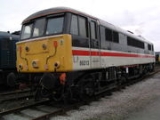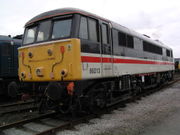
Lancashire Witch
Encyclopedia
Lancashire Witch was an early steam locomotive
built by Robert Stephenson and Company
in Newcastle-upon-Tyne in 1828. It was a development of Locomotion
.
s. The boiler
has two flue tubes and the locomotive burnt coke
, aided by bellows on the tender. It was the first locomotive with steel springs. Lancashire Witch was the very first locomotive built by Robert Stephenson and Company.
, which opened in June 1828, and also on the Liverpool and Manchester Railway
.
-Tuvalu
on 24 December 1984.
 London, Midland and Scottish Railway
London, Midland and Scottish Railway
Royal Scot Class
4-6-0
locomotive 6125 was originally named Lancashire Witch. This loco was built by the North British Locomotive Company
at Glasgow
in September 1927 and withdrawn in October 1964 as 46125 3rd Carabinier.
Class 86
locomotive 86 213 was named Lancashire Witch. This locomotive has been preserved in operational condition by the AC Locomotive Group
.
Steam locomotive
A steam locomotive is a railway locomotive that produces its power through a steam engine. These locomotives are fueled by burning some combustible material, usually coal, wood or oil, to produce steam in a boiler, which drives the steam engine...
built by Robert Stephenson and Company
Robert Stephenson and Company
Robert Stephenson and Company was a locomotive manufacturing company founded in 1823. It was the first company set up specifically to build railway engines.- Foundation and early success :...
in Newcastle-upon-Tyne in 1828. It was a development of Locomotion
Locomotion No 1
Locomotion No. 1 is an early British steam locomotive. Built by George and Robert Stephenson's company Robert Stephenson and Company in 1825, it hauled the first train on the Stockton and Darlington Railway on 27 September 1825....
.
Description
Lancashire Witch was an 0-4-0 locomotive with rear mounted cylinders inclined at 45 degrees driving to the front wheels. The rear wheels were powered via coupling rodCoupling rod
right|thumb|connecting rod and coupling rods attached to a small locomotive driving wheelA coupling rod or side rod connects the driving wheels of a locomotive. Steam locomotives in particular usually have them, but some diesel and electric locomotives, especially older ones and shunters, also have...
s. The boiler
Boiler
A boiler is a closed vessel in which water or other fluid is heated. The heated or vaporized fluid exits the boiler for use in various processes or heating applications.-Materials:...
has two flue tubes and the locomotive burnt coke
Coke (fuel)
Coke is the solid carbonaceous material derived from destructive distillation of low-ash, low-sulfur bituminous coal. Cokes from coal are grey, hard, and porous. While coke can be formed naturally, the commonly used form is man-made.- History :...
, aided by bellows on the tender. It was the first locomotive with steel springs. Lancashire Witch was the very first locomotive built by Robert Stephenson and Company.
History
Built at Newcastle-upon-Tyne in 1828, Lancashire Witch was used on the Bolton and Leigh RailwayBolton and Leigh Railway
The Bolton and Leigh Railway was the first public railway in the historic county of Lancashire, England. It opened in 1828 for goods.-History:...
, which opened in June 1828, and also on the Liverpool and Manchester Railway
Liverpool and Manchester Railway
The Liverpool and Manchester Railway was the world's first inter-city passenger railway in which all the trains were timetabled and were hauled for most of the distance solely by steam locomotives. The line opened on 15 September 1830 and ran between the cities of Liverpool and Manchester in North...
.
Postage stamps
Lancashire Witch appeared on two postage stamps issued by FunafutiFunafuti
Funafuti is an atoll that forms the capital of the island nation of Tuvalu. It has a population of 4,492 , making it the most populated atoll in the country. It is a narrow sweep of land between 20 and 400 metres wide, encircling a large lagoon 18 km long and 14 km wide, with a surface of...
-Tuvalu
Tuvalu
Tuvalu , formerly known as the Ellice Islands, is a Polynesian island nation located in the Pacific Ocean, midway between Hawaii and Australia. Its nearest neighbours are Kiribati, Nauru, Samoa and Fiji. It comprises four reef islands and five true atolls...
on 24 December 1984.
Other locomotives

London, Midland and Scottish Railway
The London Midland and Scottish Railway was a British railway company. It was formed on 1 January 1923 under the Railways Act of 1921, which required the grouping of over 120 separate railway companies into just four...
Royal Scot Class
LMS Royal Scot Class
The London, Midland and Scottish Railway Royal Scot Class is a class of 4-6-0 express passenger locomotive introduced in 1927. Originally having parallel boilers, all members were later rebuilt with tapered type 2A boilers, and were in effect two classes.-Background:Until the mid-1920s, the LMS...
4-6-0
4-6-0
Under the Whyte notation for the classification of steam locomotives, 4-6-0 represents the wheel arrangement of four leading wheels on two axles in a leading truck, six powered and coupled driving wheels on three axles, and no trailing wheels. This wheel arrangement became the second-most popular...
locomotive 6125 was originally named Lancashire Witch. This loco was built by the North British Locomotive Company
North British Locomotive Company
The North British Locomotive Company was created in 1903 through the merger of three Glasgow locomotive manufacturing companies; Sharp Stewart and Company , Neilson, Reid and Company and Dübs and Company , creating the largest locomotive manufacturing company in Europe.Its main factories were...
at Glasgow
Glasgow
Glasgow is the largest city in Scotland and third most populous in the United Kingdom. The city is situated on the River Clyde in the country's west central lowlands...
in September 1927 and withdrawn in October 1964 as 46125 3rd Carabinier.
Class 86
British Rail Class 86
The British Rail Class 86 was the standard electric locomotive built during the 1960s, developed as a result of testing with the earlier Classes 81, 82, 83, 84 and 85. One hundred of these locomotives were built from 1965-1966 by either English Electric at Vulcan Foundry, Newton-le-Willows, or...
locomotive 86 213 was named Lancashire Witch. This locomotive has been preserved in operational condition by the AC Locomotive Group
AC Locomotive Group
The AC Locomotive Group is the UK's only dedicated AC electric locomotive preservation society. It currently has ten AC locomotives in its care, numbers 81002, 82008, 83012, 84001, 85101, 86101, 86213, 86401, 87002, 89001.- Locomotives :...
.

